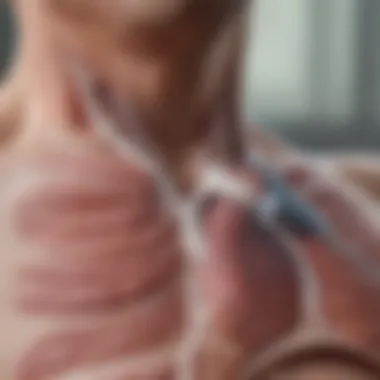Exploring Pleural Thickening in Lung Health


Intro
Pleural thickening occurs in the lungs when the pleura, which is a layer of tissue surrounding the lungs, becomes unusually thick. This condition can often signal a range of underlying issues related to lung health. The pleura has two layers: the visceral pleura, which closely adheres to the lungs, and the parietal pleura, which lines the chest wall. When these layers thicken, it may impact how well the lungs function. Understanding this condition is crucial for maintaining respiratory health, especially for those at risk of exposure to certain harmful substances or suffering from various diseases.
Key Findings
Major Results
Research has shown that pleural thickening can arise from numerous causes, including inflammation, infections, and exposure to carcinogenic substances like asbestos. Patients presenting with pleural thickening commonly experience symptoms such as shortness of breath or chest pain, but some may be asymptomatic. Imaging techniques such as X-rays and CT scans are essential for diagnosis. Studies indicate that early detection and intervention can significantly improve patient outcomes.
Discussion of Findings
The pathology leading to pleural thickening can often be linked to prolonged irritation of the pleura, resulting from either infectious processes, physical injury, or chronic exposure to harmful agents. Notably, individuals with a history of asbestos exposure are at heightened risk for developing significant thickening that may lead to complications such as pleural effusion or even mesothelioma, a severe lung cancer associated with asbestos.
"The awareness of pleural thickening is necessary for early intervention, particularly in at-risk populations."
Given these findings, it becomes clear that a multidisciplinary approach involving pulmonologists, radiologists, and oncologists may be beneficial for managing patients with this condition.
Methodology
Research Design
The examination of pleural thickening often employs a mixed-methods research design. Quantitative studies may focus on patient surveys, imaging results, and clinical data, while qualitative studies can provide insight into patient experiences and perceptions regarding their condition.
Data Collection Methods
In studies regarding pleural thickening, data is typically collected through various means:
- Imaging Techniques: These include chest X-rays and high-resolution CT scans, which help visualize the extent of thickening.
- Biopsies: In certain cases, tissue sampling may be necessary to distinguish between benign and malignant changes.
- Patient Surveys: Gathering data on symptoms can provide insights into the impact on quality of life.
By employing these diverse techniques, researchers gain insights into the occurrence, implications, and management of pleural thickening.
Prolusion to Pleural Thickening
Pleural thickening represents a significant alteration in the lung's protective lining, indicating a range of potential underlying health issues. Understanding this condition is essential due to its implications for respiratory health. This article aims to equip readers with a comprehensive view of pleural thickening, dissecting its anatomy, pathophysiology, and the factors leading to this condition.
The relevance of this discussion cannot be overstated. A detailed exploration of pleural thickening helps illuminate its connection to various respiratory diseases and conditions. Furthermore, it explores effective diagnostic approaches and management strategies, contributing valuable knowledge for healthcare professionals and researchers alike. By focusing on pleural thickening, the reader gains insight into both fundamental anatomical structures and the complexities of lung pathology, which can be beneficial in both clinical and educational settings.
Defining Pleural Thickening
Pleural thickening refers to the abnormal increase in the thickness of the pleura, which is a thin membrane surrounding the lungs. Two layers form the pleura: the visceral pleura, which directly covers the lungs, and the parietal pleura, which lines the chest cavity. Thickening of this membrane can result from several conditions, with the added tissue potentially impairing lung function, causing discomfort, and even signaling more serious health problems.
This defines pleural thickening not merely as a pathological finding but as a clinical condition with varying degrees of potential significance, which can lead to complications if left unaddressed. Recognizing and diagnosing this issue early can lead to better management and outcomes for affected individuals.
Relevance in Respiratory Health
Understanding pleural thickening is crucial in the context of respiratory health for several reasons. First, it often serves as an indicator of underlying disease processes that may affect lung function, such as infections, malignancies, or exposure to harmful substances like asbestos. As the pleura becomes thicker, the normal mechanics of breathing may be compromised, leading to symptoms such as chronic cough or difficulty breathing.
Moreover, the diagnosis of pleural thickening can prompt further investigation, which is vital for tailoring appropriate treatment strategies. Healthcare professionals must be well-versed in recognizing this condition's features and implications as they are essential for making informed decisions regarding a patient's overall health.
"The pleura's integrity is paramount in maintaining effective respiratory function. Any alterations in its structure warrant careful evaluation and management."
Anatomy of the Pleura
Understanding the anatomy of the pleura is essential for grasping the implications of pleural thickening. The pleura, a vital component of the respiratory system, consists of two thin membranes that envelop the lungs and lines the chest cavity. This region is crucial, as it plays a significant role in maintaining respiratory health and facilitating lung function. A thorough understanding of its structure and function can lead to better insights into the conditions that affect it.
Structure of the Pleura
The pleura is composed of two layers: the visceral pleura and the parietal pleura. The visceral pleura adheres tightly to the lung surface, following its contours closely. This layer is not only protective but also serves as a barrier to prevent infections from infecting both the lung tissue and the thoracic cavity. The parietal pleura, on the other hand, lines the thoracic wall and the diaphragm. It creates a space known as the pleural cavity, which contains a small amount of pleural fluid.
This fluid is critical. It reduces friction during the expansion and contraction of the lungs. Additionally, the pleura is highly vascularized, receiving blood supply from branches of the intercostal arteries and the internal thoracic artery. Understanding these structural details lays the groundwork for recognizing how changes in the pleura can lead to pathologies like pleural thickening.
Function of the Pleura
The pleura performs several key functions. Primarily, it creates a frictionless environment for lung movement. Each time we breathe, the lungs expand and contract, creating movement against the pleura. The moisture provided by pleural fluid allows this motion to occur smoothly.
Furthermore, the pleura plays a role in respiratory mechanics. It helps with lung inflation by maintaining a negative pressure in the pleural cavity. This negative pressure is vital for drawing air into the lungs during inhalation. Additionally, the pleura serves as a barrier to prevent the spread of infection and inflammation from nearby structures into the lungs themselves.
"The pleura's role in facilitating respiration while protecting against infections cannot be overstated."


Understanding the anatomy and function of the pleura paves the way for comprehending how conditions like pleural thickening arise and affect health. Awareness of these elements is vital for both medical practitioners and researchers in advancing knowledge and care regarding respiratory health.
Pathophysiology of Pleural Thickening
Understanding the pathophysiology of pleural thickening is crucial for grasping the implications of this condition on overall respiratory health. The pleura, a thin membrane covering the lungs and lining the chest cavity, can undergo various changes that signify underlying issues. This section focuses on the mechanisms and inflammatory processes that contribute to pleural thickening, demonstrating their relevance in both diagnosis and treatment.
Mechanisms of Thickening
Pleural thickening often arises as a response to pathological stimuli. Several specific mechanisms are involved:
- Fibrosis: This is a common process where connective tissue replaces normal tissue. It typically results from prolonged irritation or injury to the pleura, leading to scarring. Fibrosis disrupts normal function and can significantly affect lung expansion and contraction.
- Inflammation: Inflammatory processes can induce thickening through various cytokine release, which promotes cellular changes in the pleura. Chronic inflammation can result from conditions such as infections or autoimmune diseases.
- Fluid Accumulation: When fluid builds up in the pleural space, it can cause pressure, leading to thickening as the pleural membrane responds. This is often seen in cases of pleural effusion, where the underlying cause may be a tumor or infection.
Understanding these mechanisms is essential for delineating the condition’s progression and informing treatment strategies.
Inflammatory Processes
The role of inflammation in pleural thickening cannot be overstated. It acts as both a symptom and a causative factor.
- Acute Inflammation: This occurs in response to infections or injuries. Acute conditions can rapidly affect the pleura, causing swelling, increased fluid production, and ultimately thickening. Common infectious causes include pneumonia or tuberculosis, where pleural involvement is a sign of systemic response.
- Chronic Inflammation: Long-term inflammatory processes lead to sustained changes in the pleura, resulting in persistent thickening. Conditions such as asbestosis or rheumatoid arthritis can provoke chronic inflammatory responses. Over time, these conditions worsen the structural integrity of the pleura, contributing to further complications in lung function.
Inflammatory responses in the pleura can create a cycle of worsening symptoms, making early recognition and management essential.
These inflammatory processes warrant careful consideration, as they affect a patient’s overall health and may influence treatment decisions. Understanding them aids in developing targeted therapies that address not just the symptoms, but also the underlying causes of pleural thickening.
Causes of Pleural Thickening
Understanding the causes of pleural thickening is critical for diagnosing and managing this condition. Recognizing the underlying factors allows healthcare professionals to tailor their approach, improving patient outcomes. There are several dimensions to consider, including infectious agents, malignancies, environmental factors, and non-malignant conditions. Each cause has unique implications for treatment and progression. Identifying these causes can provide insights into prognosis and future health risks.
Infectious Causes
Infectious agents can lead to pleural thickening via inflammation, commonly seen with pneumonia. Bacterial infections, such as tuberculosis, can cause significant irritation to the pleura. Viral infections may also contribute, although less commonly.
When bacteria infect the pleural space, it can result in an accumulation of pus, known as empyema. This accumulation can lead to scar tissue formation over time, resulting in thickening. Effective medical management typically involves antibiotics. However, early diagnosis is crucial to prevent complications and reduce long-lasting effects.
Malignant Conditions
Malignant conditions often present more complexities than infectious causes. Cancers, such as mesothelioma or lung cancer, frequently involve the pleura. When tumor cells invade the pleura, they can stimulate desmoplastic reactions—an inflammatory response that contributes to thickening.
The presence of malignant pleural effusions may also occur. This happens when cancer leads to fluid accumulation, exerting pressure on the pleura, leading to further thickening. Early detection of malignancy is essential since intervention varies significantly depending on the type and stage of cancer.
Environmental Exposures
Environmental factors play a substantial role in pleural thickening, particularly from exposure to toxic substances. Asbestos exposure remains one of the most recognized causes. Asbestos fibers can migrate into the pleura, causing irritation and inflammation, which often results in pleural thickening or even fibrosis.
Additionally, exposure to pollutants or chemicals can cause similar reactions, though the relationship may not always be direct. Understanding one’s environmental history is crucial in assessing risk levels.
Non-Malignant Conditions
Non-malignant conditions also contribute to pleural thickening. Conditions like rheumatoid arthritis or lupus can cause systemic inflammation affecting the pleura. This results in a thickened pleura due to inflammatory responses.
Additionally, post-surgery adhesions can lead to thickening as well. Surgical procedures involving the lungs may predispose individuals to develop scar tissue on the pleura, further contributing to thickening.
The intricate interplay of these various causes underscores the complexity of pleural thickening and the necessity for thorough investigation in affected individuals.
In summary, understanding the causes of pleural thickening highlights its multifactorial nature. Employing a comprehensive investigative approach is vital to ascertain the underlying causes effectively, leading to appropriate management strategies.
Symptoms Associated with Pleural Thickening
Understanding the symptoms associated with pleural thickening is crucial. These symptoms often provide insight into the underlying cause of the condition and its impact on respiratory health. Recognizing these symptoms can lead to earlier diagnosis and intervention, which is vital in managing potential complications.
Respiratory Symptoms
Respiratory symptoms can be quite prevalent in individuals with pleural thickening. Commonly reported symptoms include:
- Shortness of breath (dyspnea): This is often one of the earliest and most distressing symptoms. As the pleura thickens, it can restrict lung expansion, leading to difficulty in breathing during exertion or even at rest.
- Persistent cough: A chronic cough may develop, which can be dry or productive. It often results from irritation in the pleural area or the accumulation of fluid.
- Chest pain: Pain can occur due to the stretching of the pleura or irritation of surrounding structures. This pain may be sharp or dull and vary in intensity.
The presence of these symptoms often correlates with the severity of pleural thickening. Monitoring their progression can help medical professionals assess the effectiveness of any ongoing treatment.
Systemic Symptoms
Systemic symptoms can also manifest, reflecting the body's overall response to pleural thickening. These symptoms may include:


- Fever: An elevated temperature can signify inflammation or infection, particularly if the thickening is due to infectious causes.
- Weight loss: Unexplained weight loss can occur, particularly with malignant conditions. This may be related to metabolic changes or decreased appetite.
- Fatigue: Many individuals report persistent fatigue, likely due to the body working harder to breathe and manage the underlying issues.
These systemic symptoms can provide vital clues about the underlying cause of pleural thickening and should not be overlooked in clinical evaluations.
Recognizing both respiratory and systemic symptoms is key in the early detection and management of pleural thickening. A comprehensive understanding of these symptoms can enable healthcare providers to offer timely interventions and improve patient outcomes.
Diagnostic Approaches
Diagnostic approaches are crucial to understanding pleural thickening. They help in establishing the presence of the condition, identifying its causes, and determining the appropriate treatment. A thorough diagnostic process can illuminate underlying issues that may not be immediately apparent. In this section, we will explore two main diagnostic paradigms: imaging techniques and biopsy procedures. Each method plays a significant role in assessing pleural thickening's extent and implications for respiratory health.
Imaging Techniques
Imaging techniques offer non-invasive ways to evaluate the lungs and pleura. They can categorize the types, locations, and severity of pleural thickening. Here, we will look into three primary imaging methods: Chest X-Ray, Computed Tomography (CT), and Magnetic Resonance Imaging (MRI).
Chest X-Ray
Chest X-Ray is often the first imaging test performed when pleural thickening is suspected. It provides a quick view of the lungs and surrounding structures. One key characteristic of Chest X-Ray is its ability to highlight gross abnormalities in the pleura.
Chest X-Rays are beneficial due to their availability and speed. They are often conducted in emergency departments and outpatient clinics. A unique feature of this method is that it can detect large pleural effusions or substantial thickening effectively. However, it may not depict smaller changes in detail.
Limitations: While useful, Chest X-Rays can miss smaller lesions. For comprehensive evaluation, they may need to be followed up with more detailed imaging techniques.
Computed Tomography (CT)
Computed Tomography provides a more detailed look at the pleura. It can slice through the body in ways that X-Rays cannot, offering cross-sectional images of the lungs and pleura. This method can reveal more subtle aspects of pleural thickening and any associated conditions.
A key characteristic of CT scans is high resolution, allowing for better visualization of the pleura's structure and any abnormalities in surrounding tissues. CT is often the next step after Chest X-Ray in the diagnostic process. The unique feature of this imaging technique is its ability to differentiate between various pleural diseases and assess their extent with precision.
However, the disadvantages include radiation exposure and cost when compared to traditional X-Rays.
Magnetic Resonance Imaging (MRI)
Magnetic Resonance Imaging is sometimes used for evaluating pleural thickening, especially in specific cases. It employs strong magnets and radio waves to create detailed images of soft tissues. One of its key advantages is that it does not involve ionizing radiation, making it a safer option for certain patients.
MRI can provide excellent contrast differentiation of soft tissues, allowing for a clear view of pleural structures. Its unique feature is the ability to assess both the pleura and any potential complications like intra-thoracic masses or involvement of surrounding structures.
However, MRI has limitations such as cost, longer scan times, and availability in certain settings.
Biopsy Procedures
When imaging techniques suggest abnormal pleural changes, a biopsy is often necessary for definitive diagnosis. A biopsy allows for the direct examination of pleura tissue. Various techniques can be employed, including thoracentesis and needle biopsy. Each procedure has its specific utility and indications.
Biopsy procedures can help determine if the thickening is benign or malignant. They can also provide insights into underlying infectious or inflammatory processes.
Management of Pleural Thickening
The management of pleural thickening plays a crucial role in the overall outcomes for patients diagnosed with this condition. Recognizing and addressing pleural thickening not only assists in alleviating any associated symptoms but also helps in preventing further respiratory complications. Proper management ensures that individuals are provided with adequate care tailored to their specific situation, which can differ significantly based on the underlying causes of the thickening.
Medical Treatment Options
Medical management of pleural thickening involves a multifaceted approach depending on the cause and extent of the condition.
- Anti-Inflammatory Medications: These include corticosteroids that can help reduce inflammation in the pleura, especially in cases related to autoimmune disorders.
- Antibiotics: For infections contributing to pleural thickening, antibiotics are essential for treating the underlying infectious cause, particularly if the thickening is due to pneumonia or tuberculosis.
- Management of Underlying Conditions: Effective treatment of any primary disease, such as cancer or other chronic lung conditions, is critical. This may involve chemotherapy or specific targeted therapy for malignancies that cause thickening.
Individuals experiencing significant respiratory symptoms may benefit from bronchodilators. These medications help open up the airways and improve breathing. Furthermore, physical therapy may also play a supportive role, particularly for patients whose mobility has been affected.
Surgical Interventions
In cases where medical treatments prove insufficient, surgical interventions may be necessary. Surgical options are generally considered based on the severity of symptoms and the degree of pleural thickening observed. Some common surgical approaches include:
- Pleurodesis: This is a procedure that aims to induce adhesion between the visceral and parietal pleura, helping to prevent the accumulation of fluid around the lungs. This option is often used when pleural effusions cause recurring issues.
- Video-Assisted Thoracoscopic Surgery (VATS): This minimally invasive surgery allows for direct visualization and treatment of the pleura. VATS can be employed to remove thickened pleura or to perform pleurodesis effectively.
- Thoracotomy: In more comprehensive cases, an open thoracotomy may be warranted to access the pleura for extensive evaluation and treatment.
Surgical options should be considered carefully, taking into account the patient's overall health and the potential benefits versus risks involved in the procedure.
Efficient management of pleural thickening, whether medical or surgical, is vital in ensuring a better quality of life for patients. By addressing the root causes and providing effective treatment, healthcare providers can significantly improve patient outcomes.
Prognosis of Living with Pleural Thickening
Pleural thickening is a condition that can arise from various causes, influencing the overall pulmonary health of an individual. Understanding the prognosis of living with pleural thickening is essential for both patients and healthcare providers. This insight allows for better management strategies and expectations for recovery or progression of related conditions. The prognosis can vary based on multiple factors, including the underlying cause of thickening, the extent of lung impairment, and overall health of the patient.
Factors Influencing Prognosis


Several key aspects shape the prognosis of individuals diagnosed with pleural thickening:
- Underlying Cause: Identifying whether the thickening is due to benign conditions such as infections or more serious causes such as malignancy significantly affects outcomes. Instances where infections are resolved often have better prognoses compared to those with malignant origins.
- Severity of Thickening: The degree of thickness observed in pleural imaging is a strong indicator. More pronounced thickening usually correlates with increased respiratory compromise and poorer prognostic outcomes.
- Overall Health Status: The presence of co-morbidities, like chronic obstructive pulmonary disease or heart disease, can complicate treatment and recovery. Patients in optimal health may experience better outcomes.
- Response to Treatment: How well a patient responds to medical or surgical intervention can also influence prognosis. Ongoing assessment and timely adjustments in treatment plans are crucial for comprehensive care.
- Lifestyle Factors: Smoking and other lifestyle choices can exacerbate respiratory conditions, including those caused by pleural thickening. Healthy lifestyle modifications can improve overall prognosis.
Long-Term Outcomes
The long-term prognosis for individuals with pleural thickening can vary widely. Some potential outcomes include:
- Stabilization of Condition: In cases where thickening is due to prior infections, many individuals can experience stabilization or even regression of symptoms, leading to a return to normal activities.
- Worsening Respiratory Function: For patients with thickening caused by chronic conditions or malignancy, long-term outcomes may involve progressive respiratory dysfunction and increased dependency on medical interventions.
- Management of Complications: Those who do not recover fully may need to manage complications that arise, such as pleurisy or pleural effusions. Regular monitoring is essential in these situations.
- Quality of Life Changes: Depending on symptom severity, quality of life may be impacted. Patients might face limitations in physical activity or experience respiratory distress even with mild exertion.
It is important for patients and healthcare providers to engage in open discussions about prognosis and management strategies, as this will help in setting realistic expectations and care plans.
Educating oneself about pleural thickening and its implications is vital. Ongoing research and clinical trials may provide emerging treatments and insights which could positively influence both short-term and long-term outcomes.
Preventive Measures and Lifestyle Modifications
Preventive measures and lifestyle modifications are essential in managing conditions related to pleural thickening. They play a critical role in reducing the risks associated with respiratory diseases. Understanding these aspects can empower individuals and healthcare providers in making informed decisions about lung health.
Avoiding Risk Factors
Identifying and avoiding risk factors is a fundamental step in the prevention of pleural thickening. Certain environmental and occupational exposures significantly increase the likelihood of lung damage. For instance, exposure to asbestos fibers poses a severe risk. Individuals working in construction or shipbuilding should engage in protective measures.
Several factors can be considered:
- Avoiding Smoking: Tobacco smoke contains numerous harmful chemicals that exacerbate respiratory disorders. Quitting smoking can lead to marked improvements in overall lung function.
- Limiting Air Pollution Exposure: Close proximity to areas with high pollution levels can affect lung health. Using air purifiers indoors can mitigate some risks associated with outdoor air contaminants.
- Managing Occupational Hazards: For those in high-risk jobs, using personal protective equipment is crucial. Moreover, regular health screenings can help monitor lung health and detect any changes early.
"Preventing exposure to known risk factors is a proactive approach that can significantly improve long-term respiratory health."
Lifestyle Adjustments
In addition to avoiding risk factors, making specific lifestyle adjustments can have a positive impact on lung health. These changes not only promote respiratory function but also enhance overall well-being.
Key adjustments include:
- Regular Exercise: Engage in physical activities that improve lung capacity, such as walking or swimming. This can help enhance oxygen flow and improve overall fitness.
- Balanced Diet: Consuming a diet rich in antioxidants—fruits like berries and green vegetables—can support lung health. Nutrient-dense foods aid the body in fighting off infections and inflammation.
- Hydration: Staying adequately hydrated helps in maintaining optimal mucosal membrane function, which is crucial for respiratory health.
- Stress Management: Incorporate relaxation techniques such as yoga or meditation. High stress levels can potentiate respiratory conditions, making it essential to find ways to manage stress effectively.
Implementing these preventive measures and adjustments could yield significant benefits in managing pleural thickening and improving overall respiratory health. By taking proactive steps, individuals can reduce their risk of complications and enhance their well-being.
Current Research and Future Directions
Research on pleural thickening is vital for advancing our understanding of respiratory diseases. Continuous studies not only enhance diagnostic accuracy but also open pathways for novel treatments. The importance of current research in this field cannot be overstated, as it shapes how medical professionals approach pleural thickening, leading to better patient outcomes.
Emerging Treatments
Recent findings in medical research have provided insights into new therapeutic options for pleural thickening. These treatments focus on addressing both the symptoms and the underlying causes of thickening. Targeted therapies may include the use of immunomodulators, which aim to reduce inflammation in the pleura. There is also ongoing research into the effectiveness of antifibrotic agents, which can potentially minimize the progression of thickening.
In addition, progressive techniques like video-assisted thoracoscopic surgery (VATS) are being explored. VATS allows for a less invasive approach to biopsy and excision of thickened pleura. This may result in quicker recovery times compared to traditional open surgery. Furthermore, ongoing trials are assessing the use of cryotherapy as a way to manage symptoms effectively.
Ongoing Studies
Ongoing studies are key to discovering more about pleural thickening and improving management strategies. Researchers are investigating the link between environmental exposures, such as asbestos or airborne pollutants, and the prevalence of pleural thickening. Longitudinal studies are essential in connecting these factors with the development of respiratory diseases.
Clinical trials are being conducted to evaluate the efficacy of combination therapies that target inflammation and fibrosis simultaneously. These trials focus on patient populations across various demographics, emphasizing diversity in research. The outcomes from these studies are anticipated to provide a more comprehensive understanding of how pleural thickening can be effectively managed and treated, tailoring individual patient needs.
"Research in this area is crucial as it brings hope for better treatment modalities and understanding of diseases impacting the pleura."
The results from current research and ongoing studies will play a significant role in shaping future clinical practices, improving the quality of life for patients affected by pleural thickening.
Ending
The conclusion serves as a crucial segment in the discussion of pleural thickening of the lungs. Within this article, it encapsulates the important findings and ramifications of this condition, enhancing the reader's comprehension of its complexities.
Summarizing Key Points
First, pleural thickening is a significant indicator of underlying pulmonary issues. Understanding its anatomy, causes, and implications is essential for managing respiratory health. The pleura serves critical functions related to lung mechanics, and its thickening can exacerbate respiratory symptoms. Furthermore, diagnostic approaches, whether through imaging or biopsy, offer insight into the severity and cause of the thickening. Treatment options vary widely, dictated by the underlying etiology of the condition.
- Key findings include:
- The importance of timely diagnosis
- The range of potential causes, from infections to environmental exposures
- Management strategies that include both medical and surgical interventions
- Long-term prognosis and factors that influence outcomes
This summary underscores the multifaceted nature of pleural thickening and its critical relevance to pulmonary health.
Importance of Ongoing Research
Ongoing research in the field of pleural thickening is vital. As our understanding of this condition expands, new treatment modalities and diagnostic techniques will emerge, influencing patient management. Current studies are focusing on genetic predispositions, environmental impacts, and novel therapeutic approaches. Continued exploration of these areas not only drives scientific knowledge but also has practical implications for healthcare.
"Research is the key to unlocking better health outcomes and improving the quality of life for those affected by pleural thickening."



